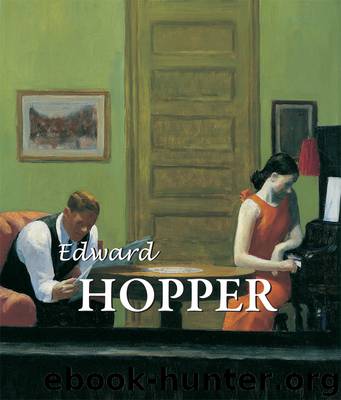Edward Hopper by Gerry Souter

Author:Gerry Souter [Souter, Gerry]
Language: eng
Format: epub
ISBN: 9781783100262
Publisher: Parkstone International
Published: 2013-12-16T16:00:00+00:00
Road in Maine, 1914.
Oil on canvas, 61.6 x 74.3 cm.
Whitney Museum of American Art,
New York, Josephine N. Hopper Bequest.
Rocks and Houses, Ogunquit, 1914.
Oil on canvas, 61.6 x 74.3 cm.
Whitney Museum of American Art,
New York, Josephine N. Hopper Bequest.
Sunday, 1926.
Oil on canvas, 73.6 x 86.3 cm.
The Phillips Collection,
Washington, D.C.
Besides bearing witness to times gone by, Hopper returned to his railway imagery in Railroad Crossing. This is an example of dynamic brushwork and composition rendering a simple scene into a deeply realised layering of light from the gravel road that crosses the tracks to the vigorous dark writhing forms of trees that almost obscure the shops and buildings at the bottom of the hill. All lines lead the eye in a rush towards the left of the composition as though a train has just raced through. A railway warning sign on the left – minus one arm – points us back into the picture. Trains hurry past this community, never pausing to look back.
More typical is Haunted House, a boarded-up storehouse among other storehouses that holds its hundreds of smells in layers of detritus left behind as ghosts from thousands of cargoes stowed in its cavernous interior. Painted quickly amid the wind-stirred golden grass, the cluster of abandoned, peak-roofed storehouses form a group that is valuable now only for its salt-scoured lumber used as panelling in rich men’s dens.
Down near the shore Hopper found beached beam trawlers: Beam Trawler Osprey and Bow of Beam Trawler Widgeon waiting for dismantling and the cutter’s torch. Hopper’s love of the sea and the irresistible tug of nostalgia helped render these bloodless fossils in dignified nuances of decay.
He paused in front of the Talbot’s House and squeezed it into his page, cropping high – slicing off the rooftop widow’s walk – low and on both sides, bulking up the brilliant whitewashed stone and brick Second Empire house with its dormered mansard roof, projecting eaves and colonnaded wrap-around porch.
Edward and Jo finally returned to Gloucester where they remained until it was time to go back to New York in the autumn. Hopper’s suitcase was crammed with thirty watercolours and the oil Gloucester Street. This depiction of houses along Church Street at the corner of Pine might have been rendered in watercolour, but Hopper chose oil and the casual sketched effect of his previous watercolours disappears. The brisk immediacy of light and dark forms with suggested details becomes a timeless actuality of real houses with basements and closets and pantries in the rear, pans on the stove, and secrets in upstairs bedroom drawers. The houses see everything passing on the street below through their window-riddled façades.
On arriving back in New York, Hopper discovered a long time fan of his work, the Washington collector Duncan Phillips, had purchased Sunday for $600, the oil that had allowed critics boundless scope to vent. In his writing of Brief Estimates of the Painters, the somewhat befuddled Phillips pegged Sunday’s location as being a “Midwestern town”, dismissing Hopper’s having painted it in Hoboken, New Jersey.
Download
This site does not store any files on its server. We only index and link to content provided by other sites. Please contact the content providers to delete copyright contents if any and email us, we'll remove relevant links or contents immediately.
Ancient Worlds by Michael Scott(2648)
Savage Harvest by Carl Hoffman(1939)
The Monuments Men by Robert M. Edsel(1757)
Cain by Jose Saramago(1516)
The Apogee - Byzantium 02 by John Julius Norwich(1422)
A History of the World in 100 Objects by MacGregor Neil(1334)
The O. Henry Prize Stories 2014 by Laura Furman(1223)
The Unfinished Palazzo by Judith Mackrell(1165)
The Swerve by Greenblatt Stephen(1136)
The Lost Secrets of Maya Technology by James A. O'Kon(1104)
Joan Miró by Joan Miró(1065)
50 Art Ideas You Really Need to Know by Susie Hodge(1059)
4 3 2 1 by Paul Auster(1034)
Cain by Saramago José(1034)
A Piece of the World by Christina Baker Kline(1005)
Heretics and Heroes by Thomas Cahill(997)
The Book of Ruby(991)
Raising Hell: A Concise History of the Black Arts and Those Who Dared to Practice Them by Robert Masello(957)
1484244826 by Unknown(942)
